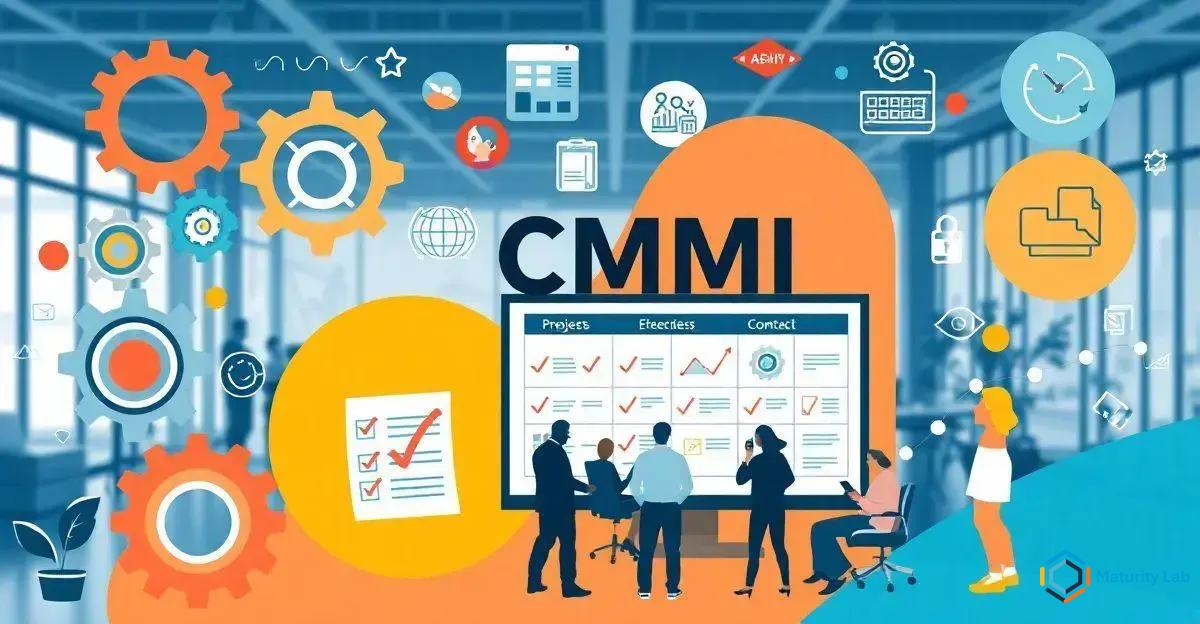CMMI, or Capability Maturity Model Integration, is a vital framework for enhancing project management and quality control processes. It establishes standardized practices that lead to consistent, high-quality outcomes by promoting data-driven decision-making, continuous monitoring, proactive risk management, and a culture of ongoing improvement. By implementing CMMI, organizations can effectively manage risks, uphold high standards, and adapt to evolving market demands, ultimately resulting in increased customer satisfaction and long-term success.
In today’s competitive business environment, the integration of CMMI (Capability Maturity Model Integration) into project management and quality control processes is crucial for achieving operational excellence. By leveraging CMMI, organizations can enhance their project management practices, improve quality control, and ensure consistent delivery of high-quality products and services. This article explores the top benefits of implementing CMMI in project management and quality control, providing valuable insights for professionals seeking to optimize their organizational processes.
Understanding CMMI and Its Importance in Project Management

CMMI, or Capability Maturity Model Integration, is a process level improvement training and appraisal program. Administered by the CMMI Institute, it is designed to help organizations improve their performance by providing them with essential elements of effective processes. The model is particularly significant in project management, as it provides a structured approach to process improvement that can lead to enhanced project outcomes.
CMMI is composed of five maturity levels, each representing a different stage of process improvement. These levels range from ‘Initial’ (where processes are unpredictable and reactive) to ‘Optimizing’ (where processes are stable and flexible, and continuous improvement is ingrained in the organizational culture). By progressing through these levels, organizations can systematically enhance their project management capabilities.
The importance of CMMI in project management cannot be overstated. Firstly, it provides a clear framework for process improvement, which is essential for managing complex projects. By following CMMI guidelines, project managers can ensure that their processes are well-defined, repeatable, and capable of producing consistent results. This is particularly crucial in industries where precision and reliability are paramount, such as software development, aerospace, and healthcare.
Moreover, CMMI helps in identifying and mitigating risks early in the project lifecycle. By establishing standardized processes, organizations can better predict potential issues and implement preventive measures. This proactive approach not only reduces the likelihood of project failures but also enhances the overall quality of deliverables.
Additionally, CMMI fosters a culture of continuous improvement. By regularly assessing and refining their processes, organizations can adapt to changing market conditions and emerging technologies. This agility is vital for maintaining a competitive edge in today’s fast-paced business environment.
In summary, understanding and implementing CMMI in project management is essential for organizations aiming to improve their processes, manage risks effectively, and deliver high-quality products and services consistently. The structured approach provided by CMMI not only enhances project outcomes but also promotes a culture of continuous improvement, ensuring long-term success.
How CMMI Enhances Quality Control in Projects

Quality control is a critical aspect of project management, ensuring that the final deliverables meet the required standards and satisfy stakeholder expectations. CMMI (Capability Maturity Model Integration) plays a pivotal role in enhancing quality control within projects by providing a structured framework for process improvement and quality assurance.
One of the primary ways CMMI enhances quality control is through its emphasis on standardized processes. By defining and documenting processes at each maturity level, CMMI ensures that project teams follow consistent procedures, reducing variability and enhancing predictability. This standardization is crucial for maintaining high-quality outputs, as it minimizes the chances of errors and defects.
CMMI also promotes the use of quantitative project management techniques. By leveraging metrics and data-driven decision-making, organizations can monitor process performance and identify areas for improvement. This analytical approach enables project managers to make informed decisions, ensuring that quality control measures are both effective and efficient. For instance, by tracking defect density and resolution times, teams can pinpoint process bottlenecks and implement corrective actions promptly.
Furthermore, CMMI encourages continuous process monitoring and evaluation. Regular assessments and appraisals help organizations identify deviations from established standards and take corrective actions. This ongoing scrutiny ensures that quality control is not a one-time activity but an integral part of the project lifecycle. By embedding quality control into daily operations, organizations can achieve sustained excellence in their deliverables.
Another significant benefit of CMMI in quality control is its focus on risk management. By identifying potential risks early in the project lifecycle, CMMI enables teams to implement preventive measures, reducing the likelihood of quality issues. This proactive approach to risk management is essential for maintaining high standards, as it allows organizations to address potential problems before they escalate.
Moreover, CMMI fosters a culture of continuous improvement, encouraging teams to regularly review and refine their processes. This iterative approach ensures that quality control measures evolve in response to changing project requirements and market conditions. By continually enhancing their processes, organizations can maintain high-quality standards and adapt to new challenges effectively.
In conclusion, CMMI significantly enhances quality control in projects by promoting standardized processes, data-driven decision-making, continuous monitoring, proactive risk management, and a culture of continuous improvement. By integrating CMMI into their project management practices, organizations can ensure that their deliverables consistently meet or exceed quality expectations, leading to greater customer satisfaction and long-term success.
Incorporating CMMI into project management and quality control processes offers substantial benefits that can significantly enhance organizational performance. By providing a structured framework for process improvement, CMMI ensures that project management practices are standardized, repeatable, and capable of producing consistent and high-quality results.
The model’s emphasis on quantitative project management techniques and continuous process monitoring allows organizations to make data-driven decisions, identify areas for improvement, and implement effective quality control measures.
Benefits of CMMI Integration
Furthermore, CMMI’s proactive approach to risk management helps in identifying potential issues early in the project lifecycle, enabling teams to implement preventive measures and reduce the likelihood of quality problems.
This not only enhances the overall quality of deliverables but also fosters a culture of continuous improvement, ensuring that organizations can adapt to changing market conditions and emerging technologies.
Ultimately, the integration of CMMI into project management and quality control processes leads to greater customer satisfaction, improved project outcomes, and long-term organizational success. By understanding and leveraging the principles of CMMI, professionals can optimize their project management practices, enhance quality control, and achieve operational excellence.
Wouldn’t it be more efficient to implement an action plan to enhance your company’s maturity after understanding its current maturity level? By utilizing tools like Maturity Lab, organizations can streamline this process, making it easier and more effective to achieve desired improvements.
Frequently Asked Questions about CMMI in Project Management and Quality Control
What is CMMI and why is it important in project management?
CMMI, or Capability Maturity Model Integration, is a process level improvement training and appraisal program designed to help organizations improve their performance. It is important in project management because it provides a structured approach to process improvement, leading to enhanced project outcomes, standardized processes, and reduced variability.
How does CMMI enhance quality control in projects?
CMMI enhances quality control by promoting standardized processes, data-driven decision-making, continuous monitoring, proactive risk management, and a culture of continuous improvement. These elements ensure that project deliverables consistently meet or exceed quality expectations.
What are the five maturity levels of CMMI?
The five maturity levels of CMMI are: Initial (processes are unpredictable and reactive), Managed (processes are planned and executed in accordance with policy), Defined (processes are well-documented and standardized), Quantitatively Managed (processes are measured and controlled), and Optimizing (focus on continuous process improvement).
How does CMMI help in risk management?
CMMI helps in risk management by identifying potential risks early in the project lifecycle and enabling teams to implement preventive measures. This proactive approach reduces the likelihood of quality issues and enhances the overall quality of deliverables.
Why is continuous improvement important in CMMI?
Continuous improvement is important in CMMI because it ensures that quality control measures evolve in response to changing project requirements and market conditions. This iterative approach helps organizations maintain high-quality standards and adapt to new challenges effectively.
How can organizations benefit from using tools like Maturity Lab?
Organizations can benefit from using tools like Maturity Lab by streamlining the process of understanding and enhancing their maturity levels. These tools make it easier and more effective to implement action plans for process improvement, leading to better project outcomes and long-term success.

